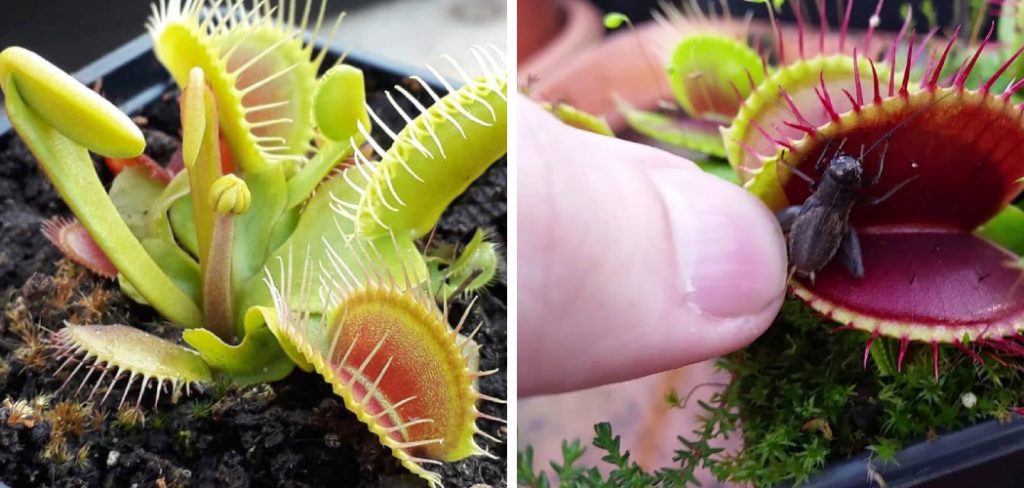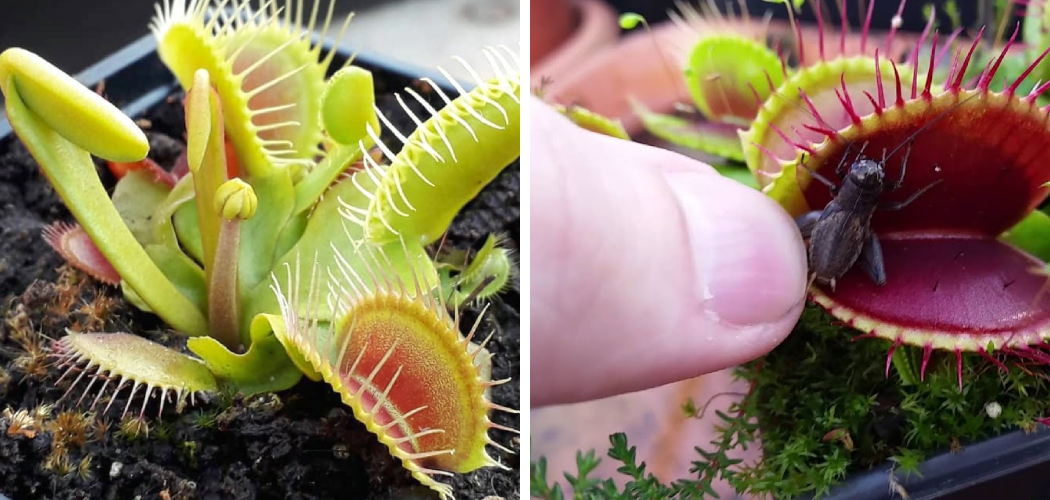To put a Venus Fly Trap into dormancy, you need to provide it with a cool environment, reduce watering, and limit exposure to light for about 2 to 3 months. Venus Fly Traps, known for their carnivorous nature and unique traps, require specialized care to thrive.
However, during certain periods, such as the winter season, it is crucial to put them into dormancy to ensure their health and longevity. Dormancy is a state of rest or hibernation that allows the plant to conserve energy and prepare for new growth in the future.
In this guide, we will explore the steps to successfully put a Venus Fly Trap into dormancy. By understanding the requirements and following the proper techniques, you can ensure the well-being of your Venus Fly Trap and enjoy its captivating beauty year after year.

Why Is Dormancy Important For Venus Fly Traps
Dormancy is crucial for Venus Fly Traps as it mimics their natural cycle. Inducing dormancy offers several benefits. It allows the plant to conserve energy, adapt to changing weather conditions, and promote strong growth. By entering dormancy, Venus Fly Traps can survive harsh winters and maximize their chances of thriving in the upcoming growing season.
During dormancy, the plant slows down its metabolic processes and enters a restful state. This period of rest is essential for the overall health and longevity of Venus Fly Traps. It’s important to understand the right conditions and techniques to put these plants into dormancy successfully.
Providing the correct temperature, light, and moisture levels will help trigger dormancy and ensure the plant’s well-being. By following the natural cycle, Venus Fly Traps can thrive and continue to captivate gardeners and plant enthusiasts alike.
When To Put Your Venus Fly Trap Into Dormancy
Putting your Venus Fly Trap into dormancy can significantly benefit its overall health and longevity. Understanding the plant’s growth stages is crucial when determining the optimal time to initiate dormancy. Look for signs such as decreased leaf production, shorter trap lifespans, and a general slowing down of growth.
Once these indications are evident, it’s time to begin the dormancy process. Reduce watering gradually, allowing the soil to dry out slightly between each watering. Aim for a cool and well-lit location for your Venus Fly Trap during dormancy. Keep the soil slightly damp but not saturated.
Avoid fertilizing or feeding the plant during this period. Dormancy, lasting around 3-4 months, allows the plant to conserve energy during its natural growth cycle. During this time, your Venus Fly Trap will enter a state of rest and will emerge healthier and more vigorous when the dormancy period ends.
Creating The Ideal Dormancy Conditions For Your Venus Fly Trap
Creating the ideal dormancy conditions for your Venus Fly Trap involves adjusting light and temperature settings, modifying watering and feeding routines, as well as providing proper airflow and humidity levels. By ensuring your plant receives indirect sunlight and lowering the temperature to around 50 degrees Fahrenheit (10 degrees Celsius), you can initiate dormancy.
Adjusting the watering schedule is vital during this period, allowing the soil to dry out between waterings. Additionally, reducing feeding or ceasing entirely helps the Venus Fly Trap conserve energy. Proper airflow is necessary, but avoid direct drafts. Maintaining humidity levels between 40% and 60% plays a crucial role in providing the right environment for the plant.
By following these guidelines, you can successfully put your Venus Fly Trap into dormancy and ensure its health and survival.
Step-By-Step Guide To Putting Your Venus Fly Trap Into Dormancy
Putting your Venus Fly Trap into dormancy is a crucial step in ensuring its health and survival. To start, gradually reduce the amount of light exposure it receives. Lowering the temperature should also be done gradually to avoid shocking the plant.
Adjusting the watering and feeding routine is a necessary part of preparing the Venus Fly Trap for its resting period. Slowly decrease the frequency and amount of water and food given to the plant. Lastly, make sure to prepare the plant for dormancy by removing any dead or decaying leaves.
By following these steps, you can successfully guide your Venus Fly Trap into dormancy, allowing it to rejuvenate and thrive in the long run.
Maintaining Your Venus Fly Trap During Dormancy
Maintaining your Venus Fly Trap during dormancy involves monitoring temperature and humidity levels. It is important to ensure that the plant is exposed to cool temperatures, ideally between 35-50°F. Additionally, keep the humidity level around 50% to mimic its natural environment.
Reducing watering frequency is crucial during this period. Only water the plant when the soil is dry to prevent root rot. Safeguarding the plant from pests and diseases is also essential. Inspect the plant regularly for any signs of infestation and take appropriate measures to control pests.
Keeping the plant in a clean and pest-free environment is key. By following these guidelines, you can successfully put your Venus Fly Trap into dormancy and ensure its optimal health.
End Dormancy And Bring Your Venus Fly Trap Back To Life
To end dormancy and bring your Venus Fly Trap back to life, gradually increase its light exposure. Raise the temperature slowly as well. It’s important to resume the plant’s normal watering and feeding routine. This will help the Venus Fly Trap recover from its dormant state.
By providing the right conditions, you can encourage new growth and ensure the plant thrives. Remember to be patient throughout this process as it may take some time for the Venus Fly Trap to fully awaken. Following these steps will help your plant transition smoothly out of dormancy and resume its active growth phase.
Troubleshooting Common Dormancy Issues With Venus Fly Traps
Venus fly traps require proper dormancy to thrive. However, sometimes issues may arise during this period. Premature emergence from dormancy can be problematic as it can lead to weak growth. On the other hand, delayed emergence can be worrisome and may indicate an underlying problem.
During dormancy, diseases and pests can still cause damage to the plant. It is crucial to monitor and address any issues promptly. Observing the plant’s environment, such as providing proper lighting and temperature conditions, is essential for successful dormancy. Maintaining a clean and pest-free environment can also help prevent diseases.
By troubleshooting common dormancy issues, you can ensure that your Venus flytrap stays healthy and continues to thrive.
Frequently Asked Questions Of How To Put Venus Fly Trap Into Dormancy
How Do You Put A Venus Fly Trap Into Dormancy?
To put a Venus Fly Trap into dormancy, you should gradually reduce the amount of light and water it receives. Cut back on watering until the soil is slightly moist and move it to a cooler location with indirect sunlight.
Allow the plant to rest for a few months before resuming normal care.
Why Is It Important To Put A Venus Fly Trap Into Dormancy?
Putting a Venus Fly Trap into dormancy is important as it mimics their natural winter conditions. Dormancy is necessary for their survival and overall health. It allows the plant to conserve energy and prepare for new growth in the coming season.
Without dormancy, the plant may weaken and die.
When Should You Put A Venus Fly Trap Into Dormancy?
It is best to put a Venus Fly Trap into dormancy during the late fall or winter months when daylight hours decrease. This mimics their natural winter conditions. Starting the dormancy period too early or too late may disrupt the plant’s growth cycle and lead to poor health or even death.
Conclusion
The process of putting a Venus Fly Trap into dormancy is crucial to its overall health and survival. By following the proper steps, you can ensure that your plant enters its dormant period successfully and emerges stronger and healthier in the spring.
First, gradually reduce the amount of water and sunlight the plant receives. This will mimic the natural conditions it would experience in its native habitat during the winter months. Next, store the plant in a cool location, such as a refrigerator or garage, where temperatures stay between 35-50 degrees Fahrenheit.
Throughout the dormancy period, it is important to avoid disturbing or feeding the plant. Finally, be patient and monitor the plant closely for signs of growth as spring approaches. By understanding and implementing these guidelines, you can provide the optimal conditions for your Venus Fly Trap’s dormancy and set it up for success in the upcoming growing season.

